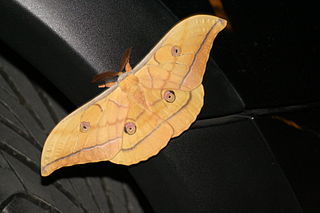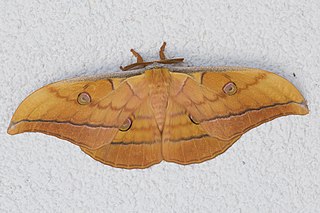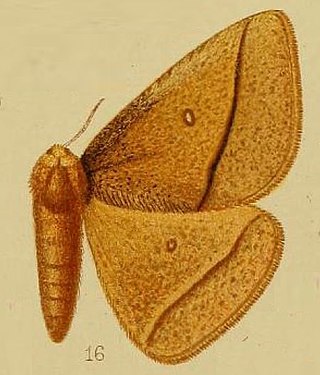
Saturniidae, members of which are commonly named the saturniids, is a family of Lepidoptera with an estimated 2,300 described species. The family contains some of the largest species of moths in the world. Notable members include the emperor moths, royal moths, and giant silk moths.

Antheraea polyphemus, the Polyphemus moth, is a North American member of the family Saturniidae, the giant silk moths. It is a tan-colored moth, with an average wingspan of 15 cm (6 in). The most notable feature of the moth is its large, purplish eyespots on its two hindwings. The eyespots give it its name – from the Greek myth of the cyclops Polyphemus. The species was first described by Pieter Cramer in 1776. The species is widespread in continental North America, with local populations found throughout subarctic Canada and the United States. The caterpillar can eat 86,000 times its weight at emergence in a little less than two months. Polyphemus moths are considered to be very polyphagous, meaning they eat from a wide variety of plants.

Antheraea yamamai, the Japanese silk moth or Japanese oak silkmoth is a moth of the family Saturniidae. It is endemic to east Asia, but has been imported to Europe for tussar silk production and is now found in southeastern Europe, mainly in Austria, northeastern Italy, and the Balkans. It seems to be spreading north and a population has been reported near Deggendorf and Passau in Germany. The species was first described by Félix Édouard Guérin-Méneville in 1861. It has been hybridized artificially with Antheraea polyphemus of North America.

Antheraea is a moth genus belonging to the family Saturniidae. The genus was erected by Jacob Hübner in 1819. Several species of this genus have caterpillars which produce wild silk of commercial importance. Commonly called "tussar silk", the moths are named tussar moths after the fabric.

Antheraea assamensis, known as the muga silkworm as a larva and Assam silk moth as an adult, is a moth of the family Saturniidae. The species was first described by Johann Wilhelm Helfer in 1837. It is found in Assam in northeast India where 99% of its production occurs.
Antheraea korintjiana is a moth of the family Saturniidae first described by Eugène Louis Bouvier in 1928. It is found in Borneo, Sumatra and Peninsular Malaysia. The larvae probably feed on Betula, Cyperus, Daphniphyllum, Quercus, Malus, Prunus, Pyrus, and Euodia.

Antheraea celebensis is a moth of the family Saturniidae first described by Watson in 1915. It is found in Sulawesi and Sundaland.

Antheraea larissa is a silkworm moth of the family Saturniidae found in Sundaland. The species was first described by John O. Westwood in 1847. The larvae feed on the endangered tree Shorea glauca.

Antheraea helferi is a moth of the family Saturniidae first described by Frederic Moore in 1858. It is found in the north-eastern Himalaya and Sundaland.
Antheraea diehli is a moth of the family Saturniidae found in Sumatra, Borneo and Peninsular Malaysia. The species was first described by Claude Lemaire in 1979.

Antheraea jana is a moth of the family Saturniidae first described by Stoll in 1782. It is found in Sundaland, the Andamans and Myanmar.
Antheraea broschi is a moth of the family Saturniidae found in eastern Malaysia.
Antheraea exspectata is a moth of the family Saturniidae found in Sulawesi.
Antheraea cihangiri is a moth of the family Saturniidae found in Pulau Peleng.

Antheraea rosieri is a moth of the family Saturniidae first described by Lambertus Johannes Toxopeus in 1940. It is found in Sumatra, Peninsular Malaysia and Borneo.

Antheraea pernyi, the Chinese (oak) tussar moth, Chinese tasar moth or temperate tussar moth, is a large moth in the family Saturniidae. The species was first described by Félix Édouard Guérin-Méneville in 1855. Antheraea roylei is an extremely close relative, and the present species might actually have evolved from ancestral A. roylei by chromosome rearrangement.

Decachorda is a genus of moths in the family Saturniidae. The genus was erected by Per Olof Christopher Aurivillius in 1898.

Antheraea paphia, known as the South India small tussore, the tasar silkworm and vanya silkworm is a species of moth of the family Saturniidae found in India and Sri Lanka. The bulk of the literature on this species uses a junior synonym, Antheraea mylitta, rather than the correct name, A. paphia. It is one of a number of tasar silkworms, species that produce Tussar silk, a kind of wild silk that is made from the products of saturniid silkworms instead of the domesticated silkworm.
Antheraea roylei is a large moth in the family Saturniidae occurring in Nepal, Thailand, Burma, Vietnam, West Malaysia, and the Himalayan regions of India. The species is considered to be the wild progenitor of the domesticated species known as Antheraea pernyi; the theory is that pernyi may have evolved from ancestral A. roylei by chromosome rearrangement during domestication.














